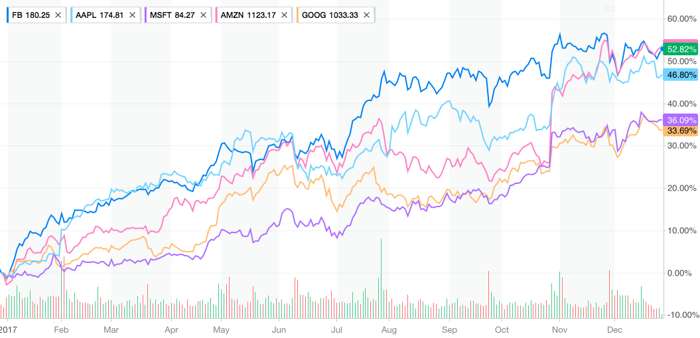8 Overly Confident, Mostly Pessimistic Predictions About Tech in 2018

Vladimir Vihrev/Shutterstock.com
The bankification of Big Tech, a strange profusion of wheeled vehicles, and more predictions about the year to come.
It was a very strange year for technology companies. They have become a “bipartisan whipping boy,” a new sexist institution, responsible for the muddying of the presidential election, “ripping apart the social fabric,” destroying a generation, and “hijacking people’s minds.”
And damn, they made a lot of money! Revenue was up. Profits were up. Share prices were way up, too. Every one of the big five—Apple, Google, Microsoft, Facebook, and Amazon—delivered a more than 33 percent increase in their share prices. Almost all of the second-tier companies also had huge years. Oracle, Salesforce, Adobe, Autodesk, HP, Dell, and Intel all saw their share prices rise more than 25 percent.
2017 Stock-Price Gains for the Big Five Tech Companies

These certainly feel like opposing trends. But who knows? I keep thinking that the rhetoric around the tech industry cannot get any darker while it continues to prosper, but 2017 provided powerful evidence to the contrary.
Prediction 1: The bankification of the tech industry will continue.
Big banks make huge amounts of money and people don’t trust them and most people use them. This is what the tech industry has to look forward to in the new year. The big tech companies will continue to be massively profitable, even as their reputation slides ever further from TED-style do-gooderism. The money and the rep are related. It is impossible to make this much money with high profit margins without people wondering what kind of hustle you’re running. Tech’s negative impact on the labor market will become increasingly clear, too, which will pair poorly with the industry’s leaders becoming the wealthiest people since the 19th-century robber barons.
Unfortunately, it won’t matter if users don’t like the evolving nature of the services. The tech industry makes incredibly convenient, useful, nearly inescapable products. Bankers are mostly okay with being hated. Will tech executives feel the same way? The tech industry can’t have it all, but what it can and will have is money.
Prediction 2: Reality will continue melting in new and terrifying ways.
If anything became clear during and after the 2016 election, it was that the informational terrain of the internet had become very, very strange. Macedonian teenagers running scam sites, random media companies producing tribalist clickbait, Russian agents, hoaxes, hyper-partisan media, and algorithmic opacity had all combined to create a world where it was hard to know where one’s Facebook feed aligned with reality, and where it diverged. Now, new artificial-intelligence techniques portend an even wilder reality, where media is even less trustworthy. Neural networks, a particular form of machine learning, can generate new audio from archival audio, making it possible to put words in the mouths of public figures. They can also generate video scenes. This is our future. People who want to really know what’s going on will have to rely on gatekeepers, whether that’s the mainstream media, analysts at research firms, or other information services.
Prediction 3: A profusion of battery-powered vehicles are coming to a bike lane near you.
A combination of factors is coming together to create a breakout year for electric vehicles that aren’t cars or scooters. It’s like a Cambrian explosion of weird vehicles. They come in all sizes and shapes: Electric-assist bicycles, single-wheels, Segway-like scooters, powered skateboards. All of these share a few common traits. One, they’re battery-powered, so they are silent and clean, benefitting from the tremendous scale of the smartphone industry’s battery needs. Two, they’re convenient and relatively inexpensive. At anywhere from $300 to a couple thousand dollars, they allow people to get around a city at a much lower cost per mile than cars or motorcycles. Three, put them in a separated bike lane and suddenly, they feel safe. Four, these vehicles are basically smartphones with wheels, so you will soon see ever more intelligence baked into them, from the ability to rent them out like a bike share to greater ease in handling. Over time, I think less and less space on urban streets will be dedicated to multi-passenger, fast-moving cars and trucks, and more to single-passenger, medium-speed vehicles. 2018 will be the year this becomes commonly accepted.
Prediction 4: You will hear and possibly even use the word monopsony.
So, we know what a monopoly is, or at least we think we do. It’s where a company dominates a market so thoroughly that there is only one seller of a type of goods. But how about a monopsony. That’s where there is only one buyer of goods. That’s the kind of power exercised by Amazon, which can tell its suppliers what it will pay, and they by and large have to deal with it. Our current—or maybe old—antitrust framework has focused on harm to consumers, not merely market concentration. If prices are lower for consumers, that’s all that matters. The actual structure of the market—how many buyers and sellers there are—isn’t part of the antitrust decision-making process. But there is a new paradigm, pushed by the Open Markets Institute, for example, that says harm to consumers is not the only way to judge the harm done by a company’s behavior. And it may especially matter in labor markets, where having a few dominant companies in an industry makes it harder for workers to get a fair share of the money pie. A legal regime that regards scale itself as a problem would be a very serious strategic problem for the current big tech players.
Prediction 5: Facebook will continue pulling out of the news business.
Several years ago, Facebook got into the news business. They made the strategic decision to court media companies and they sent LOTS of traffic as an incentive to those entities. There are now several signs that Facebook is pulling back from that strategy, emphasizing posts shared by friends, rather than pages (media or otherwise). In one six-country test, they’ve even separated out news content from the friend feed. They’ve pulled back on supporting the creation of video by media companies. And referral traffic from Facebook is down to most publishers. Now, the question is whether publishers can keep making money from readers and viewers as the Facebook tide recedes.
Prediction 6: Cameras will be a part of ever more devices, even if they don’t have screens.
Cameras have become so cheap that they are ubiquitous. They exist in all kinds of products, from cars to doorbells to baby monitors. In the past, cameras existed to display things to humans. But with the rise of machine-learning techniques that allow computers to parse images, the biggest users of cameras will be machines. And that means manufacturers will build cameras into ever more devices, so that they can exhibit low-level intelligence about their surroundings. While there will be privacy concerns, some of them will be alleviated by the devices doing more processing locally without sending information to the cloud, thanks to new chips that can run the artificial-intelligence software needed for image recognition.
Prediction 7: Autonomous vehicles will quietly become a reality.
Autonomous vehicles are in a weird part of the hype cycle. People have been seeing media reports about them for a decade and yet no one can buy one. On the other hand, tremendous strides have been made on the technology and Waymo is beginning to offer autonomous ride sharing in cars with no human driver in Chandler, Arizona, by far the most important milestone for self-driving vehicles yet. The traditional carmakers aren’t trying to sell autonomous vehicles until about 2020, but they will be offering more and more semiautonomous features. Those more pedestrian changes in the driving experience will combine with Waymo’s rollout to normalize self-driving cars. You might hear less about them next year, but they’ll come much closer to a full rollout, at least in the wealthy cities where it will make sense to deploy them.
Prediction 8: A new kind of labor movement will get a big win in the gig economy.
Most people see the gig economy as a disaster for labor organizing. People working on the other end of your favorite apps are disconnected from each other and not generally prone to seeing themselves as a class of workers who need to show solidarity. But earlier this year at the CASH Conference, I spoke with the former head of the Service Employees International Union, Andy Stern, on a panel about whether gig-economy workers could be organized. He made two points that have stood out to me. One, the sheer number of workers that could be organized via some of these apps—even just in one city—should be tantalizing to labor unions. Instead of getting 100 people in a warehouse into a union, you could be talking tens of thousands of new union members. Two, the gig-economy companies are making money (at least some of them) and that should be a draw, too, because the union could take a slice. There are some interesting movements to organize Uber drivers in Seattle and New York that could be a signal from the future.
These won’t be the only themes next year. Expect to hear more from many other areas: cryptocurrencies like Bitcoin, augmented reality, many companies making their own chips, the fragmentation of the global internet, the death of nominal net neutrality, the ongoing joke of cybersecurity, and marijuana tech. We’ll be watching all those areas in 2018, too.



